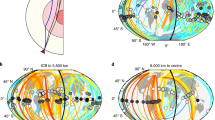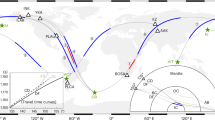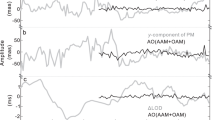Abstract
Earth’s solid inner core grows through solidification of material from the fluid outer core onto its surface at rates of about 1 mm per year1, freezing in core properties over time and generating an age–depth relation for the inner core. A hemispherical structure of the inner core is well-documented: an isotropic eastern hemisphere with fast seismic velocities contrasts with a slower, anisotropic western hemisphere2,3,4. Independently, the inner core is reported to super-rotate at rates of up to 1° per year5,6,7. Considering the slow growth, steady rotation rates of this magnitude would erase ’frozen-in’ regional variation and cannot coexist with hemispherical structure. Here, we exploit the age–depth relation, using the largest available PKIKP–PKiKP seismic travel time data set, to confirm hemispherical structure in the uppermost inner core, and to constrain the locations of the hemisphere boundaries. We find consistent eastward displacement of these boundaries with depth, from which we infer extremely slow steady inner core super-rotation of 0.1°–1° per million years. Our estimate of long-term super-rotation reconciles inner core rotation with hemispherical structure, two properties previously thought incompatible. It is in excellent agreement with geodynamo simulations8,9, while not excluding the possibility that the much larger rotation rates inferred earlier5,6,7 correspond to fluctuations in inner core rotation on shorter timescales10.
This is a preview of subscription content, access via your institution
Access options
Subscribe to this journal
Receive 12 print issues and online access
$259.00 per year
only $21.58 per issue
Buy this article
- Purchase on Springer Link
- Instant access to full article PDF
Prices may be subject to local taxes which are calculated during checkout



Similar content being viewed by others
References
Jacobs, J. The Earth’s inner core. Nature 172, 297–298 (1953).
Tanaka, S. & Hamaguchi, H. Degree one heterogeneity and hemispherical variation of anisotropy in the inner core from PKP(BC)–PKP(DF) times. J. Geophys. Res. 102, 2925–2938 (1997).
Cao, A. & Romanowicz, B. Hemispherical transition of seismic attenuation at the top of the Earth’s inner core. Earth Planet. Sci. Lett. 228, 243–253 (2004).
Deuss, A., Irving, J. & Woodhouse, J. Regional variation of inner core anisotropy from seismic normal mode observations. Science 328, 1018–1020 (2010).
Song, X. & Richards, P. Seismological evidence for differential rotation of the Earth’s inner core. Nature 382, 221–224 (1996).
Wen, L. Localized temporal change of the Earth’s inner core boundary. Science 314, 967–970 (2006).
Cao, A., Masson, Y. & Romanowicz, B. Short wavelength topography on the inner-core boundary. Proc. Natl Acad. Sci. USA 104, 31–35 (2007).
Aubert, J., Amit, H., Hulot, G. & Olson, P. Thermochemical flows couple the Earth’s inner core growth to mantle heterogeneity. Nature 454, 758–762 (2008).
Aubert, J. & Dumberry, M. Steady and fluctuating inner core rotation in numerical geodynamo models. Geophys. J. Int. 183, 162–170 (2010).
Dumberry, M. & Mound, J. Inner core–mantle gravitational locking and the super-rotation of the inner core. Geophys. J. Int. 181, 806–817 (2010).
Lehmann, I. Inner Earth. Bur. Cent. Seismol. Int. 14, 3–31 (1936).
Monnereau, M., Calvet, M., Margerin, L. & Souriau, A. Lopsided growth of Earth’s inner core. Science 328, 1014–1017 (2010).
Alboussiere, T., Deguen, R. & Melzani, M. Melting-induced stratification above the Earth’s inner core due to convective translation. Nature 466, 744–747 (2010).
Garcia, R. & Souriau, A. Inner core anisotropy and heterogeneity level. Geophys. Res. Lett. 27, 3121–3124 (2000).
Ouzounis, A. & Creager, K. Isotropy overlying anisotropy at the top of the inner core. Geophys. Res. Lett. 28, 4331–4334 (2001).
Poupinet, G., Pillet, R. & Souriau, A. Possible heterogeneity of the Earth’s core deduced from PKIKP travel times. Nature 305, 204–206 (1983).
Morelli, A., Dziewonski, A. & Woodhouse, J. Anisotropy of the inner core inferred from PKIKP travel times. Geophys. Res. Lett. 13, 1545–1548 (1986).
Woodhouse, J., Giardini, D. & Li, X. Evidence for inner core anisotropy from free oscillations. Geophys. Res. Lett. 13, 1549–1552 (1986).
Song, X. & Helmberger, D. Depth dependence of anisotropy of Earth’s inner core. J. Geophys. Res. 100, 9805–9816 (1995).
Shearer, P. Constraints on inner core anisotropy from PKP(DF) travel times. J. Geophys. Res. 99, 19647–19659 (1994).
Creager, K. Large-scale variations in inner core anisotropy. J. Geophys. Res. 104, 23127–23139 (1999).
Niu, F. & Wen, L. Hemispherical variations in seismic velocity at the top of the Earth’s inner core. Nature 410, 1081–1084 (2001).
Oreshin, S. & Vinnick, L. Heterogeneity and anisotropy of seismic attenuation in the inner core. Geophys. Res. Lett. 31, L02613 (2004).
Kennett, B., Engdahl, E. & Buland, R. Constraints on seismic velocities in the Earth from traveltimes. Geophys. J. Int. 122, 108–124 (1995).
Buffett, B., Huppert, H., Lister, J. & Woods, A. Analytical model for solidification of the Earth’s core. Nature 356, 329–331 (1992).
Labrosse, S., Poirier, J. & Le Moüel, J. The age of the inner core. Earth Planet. Sci. Lett. 190, 111–123 (2001).
Vidale, J. E., Dodge, D. A. & Earle, P. S. Slow differential rotation of the Earth’s inner core indicated by temporal changes in scattering. Nature 405, 445–448 (2000).
Laske, G. & Masters, G. Limits on differential rotation of the inner core from an analysis of the Earth’s free oscillations. Nature 402, 66–69 (1999).
Isse, T. & Nakanishi, I. Inner-core anisotropy beneath Australia and differential rotation. Geophys. J. Int. 151, 255–263 (2002).
Krasnoshchekov, D.N., Kaazik, P.B. & Ovtchinnikov, V.M. Seismological evidence for mosaic structure of the surface of the Earth’s inner core. Nature 435, 483–487 (2005).
Acknowledgements
The research was funded by the European Research Council under the European Community’s Seventh Framework Programme (FP7/2007-2013)/ERC grant agreement number 204995. We thank M. Dumberry and V. Cormier for their constructive and helpful comments.
Author information
Authors and Affiliations
Contributions
L.W. compiled and analysed the data and produced the manuscript and figures. J.I. wrote the cross-correlation code. J.I. and A.D. supervised the analysis. All authors discussed the results and implications at all stages.
Corresponding author
Ethics declarations
Competing interests
The authors declare no competing financial interests.
Supplementary information
Supplementary Information
Supplementary Information (PDF 700 kb)
Rights and permissions
About this article
Cite this article
Waszek, L., Irving, J. & Deuss, A. Reconciling the hemispherical structure of Earth’s inner core with its super-rotation. Nature Geosci 4, 264–267 (2011). https://doi.org/10.1038/ngeo1083
Received:
Accepted:
Published:
Issue Date:
DOI: https://doi.org/10.1038/ngeo1083
This article is cited by
-
Imaging the top of the Earth’s inner core: a present-day flow model
Scientific Reports (2024)
-
An initial map of fine-scale heterogeneity in the Earth’s inner core
Nature Geoscience (2022)
-
Earth’s gradients as the engine of plate tectonics and earthquakes
La Rivista del Nuovo Cimento (2022)
-
Dynamic history of the inner core constrained by seismic anisotropy
Nature Geoscience (2021)
-
AtmoFlow - Investigation of Atmospheric-Like Fluid Flows Under Microgravity Conditions
Microgravity Science and Technology (2019)



